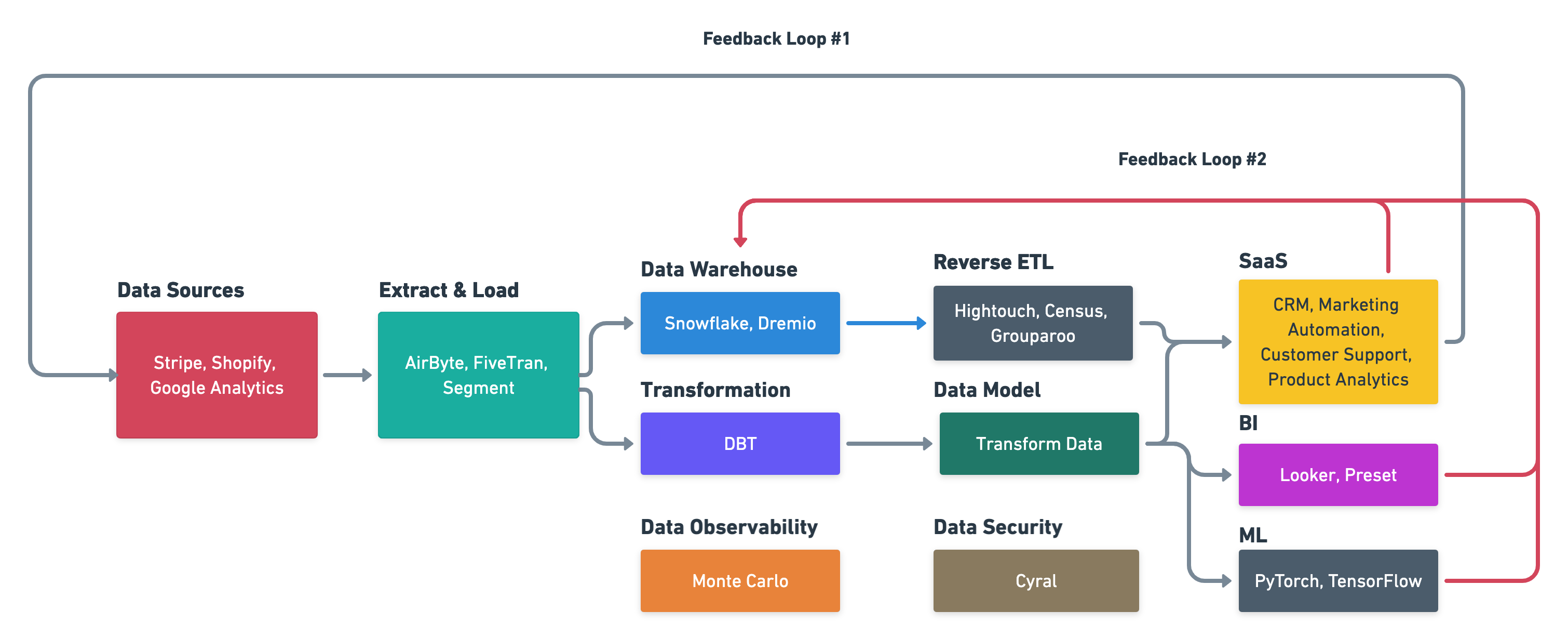About a year ago, I wrote a post on the hub and spoke data model. The idea is that in the future SaaS applications would be built on a single database, instead of each SaaS application writing to its own proprietary database.
I was wrong about the catalyst for this hub-and-spoke model. I thought it would be cloud-prem and customers driving SaaS products to use a single database. Instead, the SaaS ecosystem and the data ecosystem are moving in this direction on their own.
We haven’t seen an architectural shift in SaaS since the advent of the multi-tenant database, which allowed SaaS companies to put all of their data across customers on a single database. This may be the next shift.
Let’s talk about the innovation and then the implications.
Here’s a schematic (click to enlarge) that describes how data flows with a cloud datawarehouse (CDW) fed SaaS app. Data arrives from various systems, is transformed, and stored in Snowflake. Then the modern SaaS applications connect to the CDW via reverse-ETL or through direct connection. The SaaS applications present insights and queue workflows and help their users achieve their goals as normal, using the data from the CDW.
Underpinning this modern data stack, a data observability platform like Monte Carlo and a data security layer like Cyral ensures the data is accurate and safe.
The first feedback loop influences users and customers. A company with this architecture will map out the customer journey sufficiently well to develop proxy metrics, leading indicators of customer behavior. When will this customer persona upgrade? Should we send them an in-product message? Should a sales person call them? Should we build a new product feature to satisfy their needs? Customer interactions evolve and that feeds the CDW downstream.
The second feedback loop outputs data products and insights that are then fed into the data warehouse layer for downstream consumption, perhaps in the form of dashboards in SaaS applications or machine learning models and associated metadata. SaaS applications also write back to the CDW directly.
For example, a financial analyst might use data from the CDW to project different scenarios for this year’s board plan. A data scientist might develop a churn prediction algorithm. Or a security researcher might identify a vulnerability in customer systems that violate the company’s SOC2 certification.
These two feedback loops accelerate, spinning the data flywheel pushing more information into the data warehouse. This in turn encourages more SaaS applications, BI systems, and machine learning systems to rely on the CDW as a backend and single integration point.
The second major change is modern SaaS applications will be rearchitected. Modern SaaS applications will present materialized views from the CDW. They will write back to the CDW, creating that second feedback loop. And they will start out full of insight because they benefit from the collective marketing, support, product, engineering, and every other data set owned by the company, rather than an empty system of record.
Let’s make this a bit more tangible: a modern accounting system will be a series of queries on a data warehouse fed by APIs, not a hand-reconciled general ledger assembled by a team of staff accountants. Each scenario is stored in the CDW and is then used to inform future financial models, and even goals in marketing and sales SaaS products. As sales team change their behavior, this updates the model. Spin, flywheel, spin.
SaaS applications may maintain a separate database of their data containing application state, user permissions and other metadata, but increasingly, the core data that used to course through a system of record will be pushed/copied to the CDW. Data like customer contracts, contact history, event attendance, product usage.
This worldview implies two important themes:
- The cloud data warehouse will become an increasingly central part of the SaaS stack, not just the data stack.
- The architecture enables SaaS companies to reimagine the largest categories of software and rebuild them to challenge the incumbents.
The future won’t be as elegant as this diagram describes. Nor will this transition be immediate. But I’m convinced this new architecture will shake up the SaaS ecosystem in a big way.
